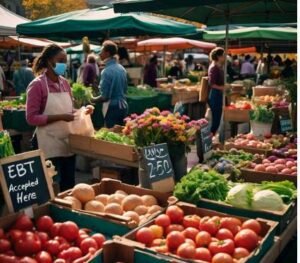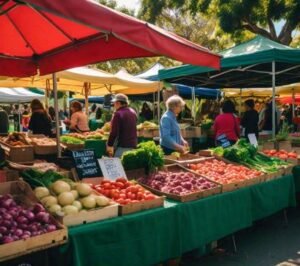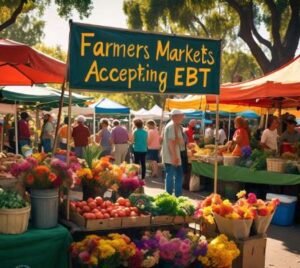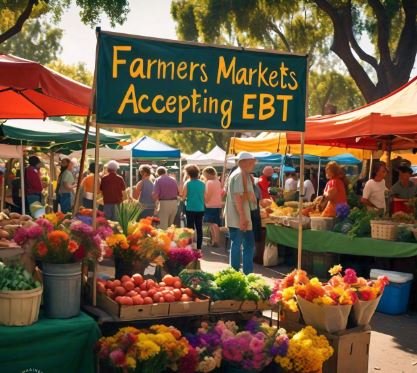Farmers markets have long been a hub for fresh, local produce, offering an opportunity for individuals to purchase high-quality fruits, vegetables, and other products directly from growers. However, for many low-income families, the ability to access these markets can be challenging. With the growing recognition of food insecurity and the importance of healthy eating, the question of whether farmers markets accepting EBT can truly provide a healthy opportunity or if they still represent a form of limited access remains critical.
In this article, we will explore the concept of farmers markets accepting EBT, examining both the positive aspects of this program and the challenges that persist. Does this initiative create greater access to healthy foods for low-income communities, or does it still leave gaps in availability and accessibility?

What Does It Mean for Farmers Markets to Accept EBT?
The farmers markets accepting EBT initiative allows Supplemental Nutrition Assistance Program (SNAP) recipients to use their EBT cards to purchase food at participating farmers markets. EBT, or Electronic Benefit Transfer, is a system that distributes government benefits like food stamps to eligible individuals. Traditionally, these benefits could only be used at grocery stores, but an increasing number of farmers markets are now adopting this method to allow individuals to spend their benefits on fresh produce and other healthy items directly from local farmers.
By accepting EBT, farmers markets aim to bridge the gap between low-income families and access to nutritious, locally sourced foods. However, the extent to which farmers markets accepting EBT actually achieve this goal can depend on various factors, including geographic location, market participation, and logistical challenges.
The Benefits of Farmers Markets Accepting EBT
- Increased Access to Fresh, Healthy Food
One of the most significant advantages of farmers markets accepting EBT is that it provides low-income individuals and families with access to fresh, nutritious produce. In many urban and rural areas, grocery stores may not offer fresh produce at affordable prices, or they may not carry the same variety available at farmers markets. For SNAP recipients, this initiative opens doors to a wider selection of fruits, vegetables, and other healthy food options.
Farmers markets often feature seasonal, locally grown produce, which can be a healthier alternative to processed and pre-packaged foods commonly found in traditional grocery stores. By accepting EBT, farmers markets offer an opportunity for low-income families to eat better and improve their overall health, without having to pay higher prices for organic or fresh foods at conventional stores.
- Supporting Local Farmers and Communities
When farmers markets accept EBT, the benefits extend beyond just the individuals using the program; local farmers and small-scale producers also gain an opportunity to reach a broader audience. Many small farmers rely on direct sales to consumers at farmers markets, and the ability to accept EBT increases their customer base, helping them to thrive and sustain their businesses.
Moreover, this initiative helps to strengthen local economies. When people use their EBT at farmers markets, the money spent remains within the community, supporting local agriculture and creating a more resilient food system. This fosters a sense of community, promotes sustainable agriculture, and ensures that fresh food is available locally, which can benefit everyone in the area.
- Encouraging Healthier Lifestyles
Access to healthy food is not just about nutrition; it’s also about forming healthy habits. By making fresh produce more accessible, farmers markets accepting EBT encourage healthier eating patterns. Individuals and families who may otherwise not have the means to purchase fresh food can now make healthier choices. The convenience and diversity of products at farmers markets help in educating people about nutrition and making food shopping a more rewarding experience.
- A Sense of Community and Connection
Farmers markets are not just about food; they are also about community engagement. Farmers markets accepting EBT can create a space where people from different socioeconomic backgrounds come together. This helps to break down social barriers and fosters connections among people, local farmers, and businesses. It is also an opportunity for SNAP recipients to interact with local growers and learn more about the source of their food, something that is often missing from traditional grocery store experiences.
The Challenges of Farmers Markets Accepting EBT
- Limited Availability Across Areas
While more and more farmers markets accepting EBT are popping up, the reality is that this service is still not universally available. The extent to which farmers markets accept EBT can vary greatly depending on the location. In rural or remote areas, for example, access to participating farmers markets may be limited or even non-existent. In urban areas where more farmers markets exist, the challenge may be less about availability and more about ensuring that they accept EBT and offer a wide variety of products.
Additionally, not all farmers markets have the infrastructure or financial resources to process EBT transactions. Some markets may need to invest in EBT processing systems, which could require both time and money that small, local markets may not have. As a result, while some farmers markets accepting EBT can provide the service with ease, others may face barriers that limit their ability to fully participate.

- Restrictions on Eligible Purchases
Another limitation of farmers markets accepting EBT is that the benefits can only be used to purchase food items that are eligible under the SNAP program. This means that non-food items such as flowers, arts and crafts, or even prepared hot foods are not eligible for purchase with EBT. While this is in line with the SNAP guidelines, it can be limiting for shoppers who are hoping to use their EBT benefits for more than just fresh produce. This restriction may prevent some individuals from fully utilizing their EBT benefits at farmers markets.
- Lack of Awareness and Education
For farmers markets accepting EBT to have a real impact, people need to know they are available and how to use them. In some communities, there is still a lack of awareness about which markets accept EBT and how the system works. Without proper outreach and education, many eligible families may not take full advantage of this opportunity. Furthermore, the process of using EBT at farmers markets can be confusing for some shoppers, especially those who are unfamiliar with the technology or who may need additional assistance.
- Logistical Issues with EBT Redemption
Using EBT at farmers markets often involves additional steps compared to traditional grocery shopping. For example, at some farmers markets, participants may need to visit a central booth or kiosk to exchange their EBT card for market tokens, which can be used at individual vendors. While this system is effective, it can be cumbersome and may discourage people from using their EBT benefits at the market. Additionally, some farmers markets may limit the amount of EBT benefits a person can use in a single transaction, creating further logistical challenges for consumers.

In recent years, the ability to use Electronic Benefit Transfer (EBT) for grocery shopping has become a critical tool for many low-income individuals and families. With the rise of online grocery shopping and curbside pickup services, the question of states accepting EBT for grocery pickup has become increasingly relevant read more.
Is This Initiative a Healthy Opportunity or Limited Access?
In conclusion, farmers markets accepting EBT provide a valuable service for low-income families by offering access to fresh, local produce and helping support small, local farmers. It is undeniably a step in the right direction for improving food access and encouraging healthier eating habits. However, there are still several limitations that prevent it from being an ideal solution for all families. Geographic availability, restrictions on eligible products, and logistical challenges still make farmers markets accepting EBT a service with limited access in certain areas.
To make this initiative more impactful, improvements in outreach, infrastructure, and awareness are necessary. If farmers markets accepting EBT can overcome these challenges, they have the potential to become a cornerstone in addressing food insecurity and promoting healthier communities across the country. Until then, while it may not be a perfect solution, it is certainly a valuable opportunity that should continue to grow and expand.




